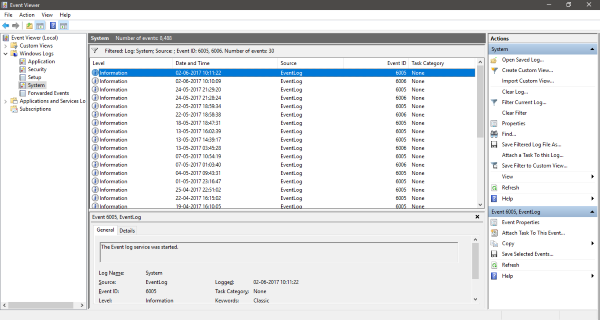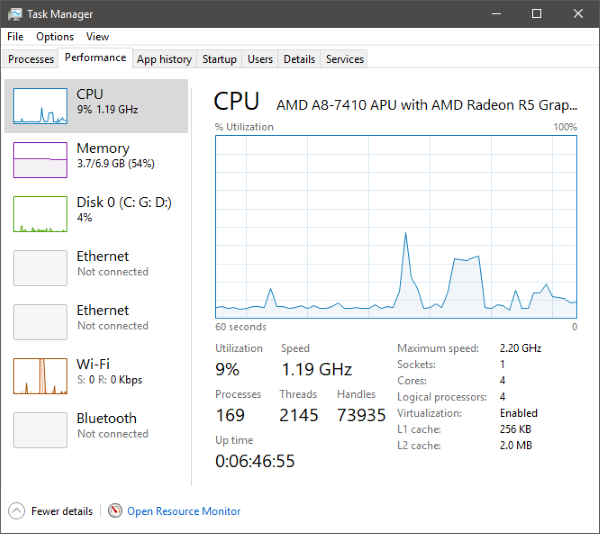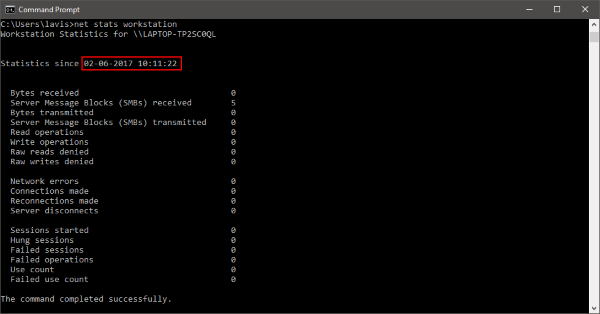Our Windows laptops and PCs keep running for long these days. Can you remember the last time you shut down your PC? Users these days consider putting their computers to Sleep in order to get back faster.
Did you know that your computer logs the timestamp every time you shut down or start your computer? The total duration for which your computer has been running is called Uptime. And the duration for which the computer was powered off is called Downtime.
The uptime or downtime figures may not be important for an average daily user. But if you are using your computer as a server in your organization then these figures might be of interest. Also, if you are interested in monitoring your computer, these figures may help you out. In this post, we will discuss the ways you can find out Windows Downtime and the Last Shutdown Time.
How to check Last Shutdown Time or Downtime in Windows 11/10
1] Using Event Viewer
The Event Viewer is a built-in Windows utility that lets you view various events logged by Windows. As I already mentioned, Windows logs the last shutdown and start-up time, and it can be found in Event Viewer.
Follow these steps to find out the last time your PC was ‘Shut down’.
- Go to Start and search for ‘Event Viewer’ and hit Enter.
- Expand ‘Windows Logs’ from the left ‘Console Tree’. And select ‘System’ from it.
- Wait for all the events to load. Now click on ‘Filter current log’ from the right ‘Action Pane’.
- Now in the text box that says “<All Event IDs>”, replace the text with “6005, 6006”.
- Refresh the current log.
- Sort the list based on the time and date of the logged event. The latest entries being on the top of the list.

Now you’ve filtered and sorted the list to give you all the required information. The first entry in the list with the Event ID 6006 gives you the last time your computer was Shut Down. And the first entry with ID 6005 gives you the time when the PC was started again.
The difference between both the timestamps gives you the net downtime – or the duration for which the computer was in a completely powered-down state. Also, the difference between your current time and the last start time can give you the total uptime of your computer.
Current Time – Last Start Time = Total Uptime
Last Start Time – Last Shut Down Time = Total Downtime
Read: Monitor Windows Startup & Shutdown times with TurnedOnTimesView
2] Using Task Manager

This method is rather an easy way to calculate Uptime, but it does not calculate Downtime. All you need to do is open ‘Task Manager’ and go to ‘Performance’ tab. Select ‘CPU’ from the left menu, and now look for ‘Uptime’ in the right section.
The total uptime would be displayed in DD:HH:MM:SS format. Using Task Manager will be fine if you are looking for current uptime only. It cannot display the entire history of events, whereas in Event Viewer, you can go back in time and view earlier event logs and calculate Uptime and Downtime accordingly.
Read: How to find Process Start and End Time in Windows
3] Using CMD

Viewing the statistics of the Workstation service can also give you the last start time. To do so, open ‘CMD’ and type the following command:
net stats workstation
The response would start with ‘Statistics Since ….”. The timestamp in this line is the time when the computer started from a complete shutdown.
Also read: How to check Uptime in Windows using PowerShell, CMD, and the Task Manager, etc.
If you are working with Windows Server, then you may probably need some better monitoring tools, but these simple methods will also work. Also, these figures only apply to shutdowns and restarts. These figures do not represent Sleep, Logoff, Logon, or hibernation times.
TIP: The built-in SystemInfo tool lets you view the System Boot Time. It displays the date and time at which the computer booted.
BONUS TIP: This post will show you how to find out the Windows Installation Date using various methods.
Great information to see most methods in one place to find last shutdown and restarted time. It helped me to find time of shutdown of downloading games in laptop running in battery backup.